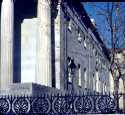Click to Enlarge

Fig. 1 - 2nd Bank of US -Philadelphia - Doric Columns

Fig. 2- Parthenon
Athens
Doric Columns

Fig. 3 - Side View
2nd Bank of US
Philadelphia
The Second Bank of the United States, located in Philadelphia, was constructed between 1819 and 1824 and still remains one of America's greatest examples of Greek Revival Architecture. The bank was conceived by William Strickland, an American born architect, who was once considered to be an undisciplined apprentice of Henry Latrobe. The Second Bank of the United States was Strickland's first major design and the first true example of the Greek Revival in America.
When the published note of the building
was released to the public before actual construction began, it read, "...in
this edifice, the directors are desirous of exhibiting a chase imitation
of Greek architecture, in its simplest and most inexpensive form." The
word imitation here is noteworthy. The Greek Revival Style was not
a direct copy of Grecian buildings, but rather an adaptation. The
building's facades (see fig. 1) are fancied after the Parthenon (see fig.
2), boasting north and south Doric porticoes, but the exterior columns
do not run along the entire building, but merely anchor the ends (see fig.
3). This was done for logistical purposes - namely, to allow the building
to fit into the block between 4th and 5th Streets in Philadelphia.
| Slide
Gallery:
Click to Enlarge |

Fig. 1 - 2nd Bank of US -Philadelphia - Doric Columns |

Fig. 2- Parthenon
|

Fig. 3 - Side View 2nd Bank of US Philadelphia |
The interior of the building is representative of the improving technology in architecture in nineteenth century America. The vaulting ceilings serve more than an aesthetic purpose - they work to make the building more resistant to fire.